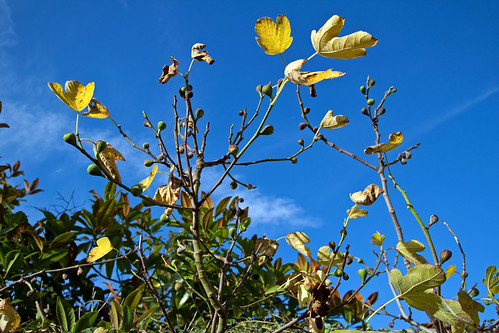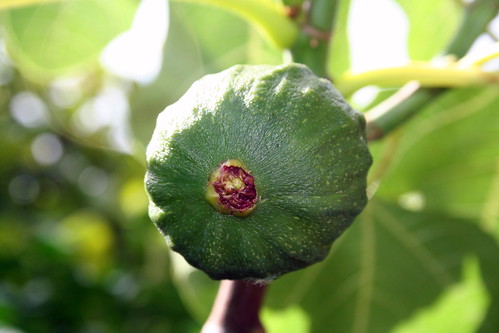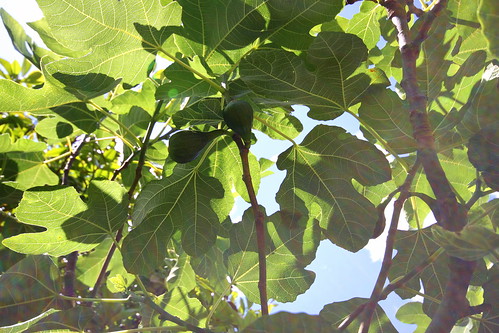My fig tree has now lost nearly all of its leaves and the bare branches just carry the fruit that failed to ripen during the summer. The branches and figs look a little sad silhouetted against the November sky.
Above (Fig 1) Fig Tree in November
I grow the variety Ficus carica ‘Brown Turkey’ planted up against the wall of the garage. It is said that to get a productive fig tree that you should restrict the roots by lining the planting hole with some sort of impervious product. Mine is planted into virtual rubble and I hope / think that this achieves the same objective. In this country, planted outdoors, figs will only produce one crop a year unlike if grown under glass or in warmer countries where 2 crops are achievable. This is why, as you will see in the above photo, my tree has a lot of figs that will now not ripen. These should ideally be removed leaving only the very small pea-sized embryonic figs that will produce next year’s crop if they survive the winter.
Our crop varies from year to year, the number of figs harvested depends on whether the birds or maybe squirrels get there first. I could protect the crop from birds with netting but then . . . . I don’t much like figs"!
Above (Fig 2): A nearly ripe fig produced on the Musa Estate
A Bit More Information . . .
The Fig is not exactly a fruit, the so-called fruit is, in fact, a cluster of flowers held within its skin. The flowers are pollinated by small wasps, each species of fig has a specific species of wasp able to enter the ‘fruit’ through the small opening at the end of the fruiting body. I believe some species of fig are also pollinated by ants. By the way, cultivated figs such as Brown Turkey are able to produce ripe ‘fruits’ without pollination, which is useful as the required species of pollinating wasps are not present in the UK.
So, Ficus carica is not able to set seed in the UK. However, there are wild fig trees growing along some of our river banks in England! It seems that these wild fig trees are the result of germination from seeds contained within sewage pumped into the rivers. The seeds must originate from imported dried and fresh figs and have passed through human digestive tracts. It is also likely that germination had been aided by higher water temperatures caused by the outflow of industrial cooling waters as these wild fig trees tend to be found along the banks of rivers passing through former industrial areas. Most of these wild trees are now very old and I hope this signifies that we are no longer pumping sewage into our rivers or industrial cooling water.
I believe that California has a problem with the invasiveness of Ficus carica introduced to that country but but that is not caused by the above reasons as I understand they are trying to eradicate the relevant pollinating wasp to control the spread.
I find the subject of the cultivated fig interesting as it has many historical connections to the ancient civilizations of Greece, Rome and Egypt, an interesting botany and, of course, several biblical references. I don’t think there is a book currently in print on the subject but I will have a browse on eBay.
As an aside . . . . I used to notice tomato plants growing on the high spring tide mark of a bay nearby. These plants also germinated as a result of sewage being pumped into the sea. I’m pleased to say that this no longer occurs . . . . . or perhaps I just haven't looked lately!
Above (Fig 3): The fig tree in summer
I like my fig tree for its structure and leaves with prominent veining. I’m not keen on eating figs but I like having the tree around!



I love this sturdy tree. It produces beautiful tropical foliage and can handle our summer heat here in Tucson. I hate fig newtons....or dried figs...as they are disgusting.....but fresh figs off the tree are really good. I got my first crop this year and they did not disappoint.:) I had no idea that sewage and fig went together in some parts of the world:) So the saying should really be...."Figs happen:)"
ReplyDeleteYeah - and they are also known for their laxitive qualities! I've never heard of Fig Newtons so I searched via Google - it seems they are an American brand of what we call Fig Rolls, I don't like them much either and they are not that popular generally.
ReplyDeleteI agree about the tropical foliage, it is good. My tree is trained against the garage wall but it is beginning to get too big, I shall have to cut it hard back, the last thing my garden needs is more shade.
I'd be interested to research more into plants that are spread via human sewage, of course, it is part of many plants plans that their seed is spread by birds and mammals.
I'd like to end with some witty comment involving sewage etc but can't think of anything . . . . Fig!
chrome hearts online
ReplyDeletenike zoom kobe
cheap oakleys
michael kors outlet
michael kors outlet online
michael kors handbags
michael kors outlet
adidas stan smith uk
michael kors outlet online
tiffany and co outlet
air jordan shoes
ray ban uk,cheap ray ban sunglasses
http://www.outlettiffanyand.co
nike roshe run
true religion jeans wholesale
nike air zoom pegasus 32
air max thea
cheap air jordan
tiffany and co outlet
michael kors handbags,michael kors handbags clearance,michael kors clearance
mlb jerseys shop
cheap mlb jerseys
christian louboutin shoes
ralph lauren online,cheap ralph lauren
chrome hearts
jordans for cheap
nfl jerseys from china
cheap oakley sunglasses
kobe shoes
roshe run
true religion jeans
cheap jordans online
yeezy boost
fitflops
huarache shoes
oakley sunglasses wholesale
http://www.chromehearts.us.com
michael kors outlet